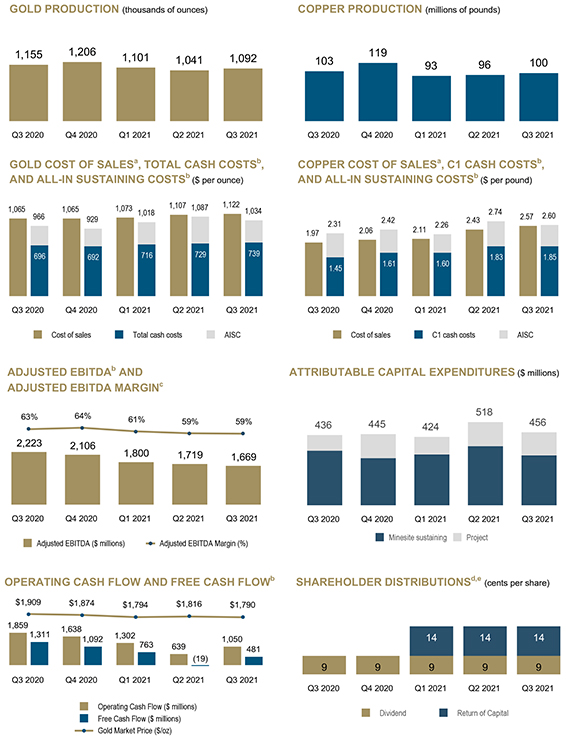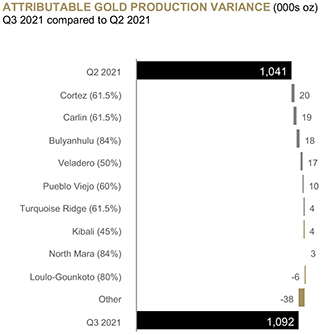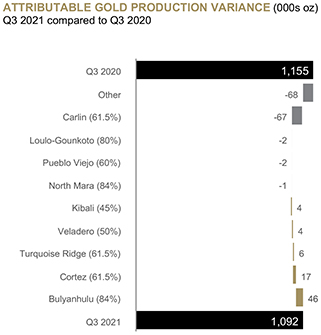carbonaceous content for the majority of the third quarter to take advantage of extra retention time in the roasting circuit to deliver a higher recovery from this ore type. This has allowed us to optimize roaster throughput and recoveries that should positively impact the fourth quarter of 2021 and beyond. Higher grade underground ores were also stockpiled through the repair period and are expected to be processed in the fourth quarter of 2021. Total tonnes mined were 6% higher compared to the prior quarter, driven by the open pit. Open pit ore tonnes mined were 94% higher compared to the prior quarter, driven by an increase in heap leach ore mined from the Gold Star pit. Average open pit mined grade was in line with the prior quarter. Underground mined tonnes and grade were 5% lower and 7% higher, respectively, due to mine sequencing across the complex’s underground mines. Cost of sales per ounce2 and total cash costs per ounce1 in the third quarter of 2021 were 2% and 4% lower, respectively, than the prior quarter due to continued cost discipline combined with the impact of higher sales volume. In the third quarter of 2021, all-in sustaining costs per ounce1 were 14% lower than the prior quarter due to lower total cash costs per ounce1 and lower minesite sustaining capital expenditures. Capital expenditures in the third quarter of 2021 decreased by 32% compared to the prior quarter, due to the purchase of an oxygen plant at the Goldstrike autoclave during the prior quarter. The oxygen plant was previously owned by a third party and the purchase is expected to reduce operating costs going forward. Q3 2021 compared to Q3 2020 Carlin’s income for the three month period ended September 30, 2021 was 40% lower than the same prior year period, mainly due to a decrease in sales volume combined with a lower realized gold price1. Gold production for the three month period ended September 30, 2021 was 24% lower compared to the same prior year period, mainly due to the mechanical mill failure at the Goldstrike roaster as described above. In addition, lower production from the Goldstrike autoclave was mainly driven by the transition from acid to alkaline ore. As previously disclosed, the Goldstrike autoclave completed processing of acidic ore at the end of the third quarter of 2020. Total tonnes mined were largely in line with the same prior year period. At the open pit mines, higher ore tonnes mined offset lower waste stripping. Waste stripping continued at the Goldstrike 5th NW layback whereas in the same prior year period, there was ore mining at the 4th NW layback in addition to stripping of the 5th NW layback. In the Gold Quarry and Gold Star open pits, mining continued to advance in ore, resulting in lower capitalized waste tonnes mined compared to the same prior year period. Average open pit mined grade decreased by 74%, due to the mining of a higher proportion of heap leach ore compared to the same prior year period. Underground tonnes mined and grade were slightly lower compared to the same prior year period, 5% and 7% respectively, driven by a change in the mix of ore sources across the different underground operations as per the mine plan. Cost of sales per ounce2 and total cash costs per ounce1 for the three month period ended September 30, 2021 were 3% and 2% higher, respectively, than the same prior year period, mainly due to a decrease in sales volume although this was largely mitigated through continued cost | | | | discipline. For the three month period ended September 30, 2021, all-in sustaining costs per ounce1 increased by 8% compared to the same prior year period, primarily due to the impact of higher minesite sustaining capital expenditures on a per ounce basis. Capital expenditures for the three month period ended September 30, 2021 decreased by 7% as lower capitalized waste stripping was slightly offset by higher minesite sustaining capital expenditures and underground capital development. YTD 2021 compared to YTD 2020 Carlin’s income for the nine month period ended September 30, 2021 was 12% lower than the same prior year period due to a decrease in sales volume, partially offset by a higher realized gold price1. Gold production for the nine month period ended September 30, 2021 was 18% lower compared to the same prior year period, mainly due to the mechanical mill failure at the Goldstrike roaster which negatively impacted production in the current period. In addition, lower production from the Goldstrike autoclave was mainly driven by the transition from acid to alkaline ore. As previously disclosed, the Goldstrike autoclave completed processing of acidic ore at the end of the third quarter of 2020. Total tonnes mined increased 8% compared to the same prior year period, mainly due to shorter hauls as the Goldstrike open pit has transitioned from mining ore from the 4th NW layback to stripping of the 5th NW layback. Open pit ore tonnes mined decreased by 1% compared to the same prior year period, due to the above mentioned transition to stripping at the Goldstrike open pit, partially offset by an increase in heap leach ore mined from Gold Quarry and Gold Star. Average open pit mined grade decreased by 66% due to the mining of a higher proportion of heap leach ore compared to the same prior year period. Underground tonnes mined were 1% higher compared to the same prior year period due to upgraded equipment and increased haulage capacity, while underground mined grade decreased by 9% driven by a change in the mix of ore sources across the different underground operations as per the mine plan. Cost of sales per ounce2 and total cash costs per ounce1 for the nine month period ended September 30, 2021 were both in line with the same prior year period, with operating cost discipline offsetting the impact of lower sales volume. For the nine month period ended September 30, 2021, all-in sustaining costs per ounce1 increased by 9% compared to the same prior year period, primarily due to the impact of higher minesite sustaining capital expenditures. Capital expenditures for the nine month period ended September 30, 2021 increased by 13% mainly due to an increase in capitalized waste stripping and the purchase of an oxygen plant at the Goldstrike autoclave, which was previously owned by a third party and is expected to reduce operating costs going forward. |


